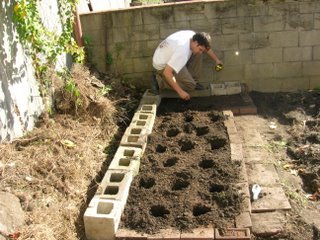This morning I planted the first round of seeds into the cold frame. The cold frame slopes to the south and the long edges run from east to west. I planted each of the following in two foot long rows that run from east to west, each about 2.5" apart from the next row:
- Lettuce, Green Grand Rapids Black Seeded Simpson variety. I planted these about 1" apart and at the northern most spot of the cold frame. Expected time until germination is approximately 3 to 5 days, though it may take longer given the cold weather.
- Lettuce, Green Bib Deer Tongue variety. Again, I planted these about 1" apart. The row is directly below the Green Grand Rapids Variety. Expected time until germination is approximately 3 to 5 days, though it may take longer given the cold weather.
- Greens, Mache/Corn Salad Vit variety. I planted these a little less than 1" apart, directly below the Lettuce, Green Bibb Deer Tongue variety. Mache germinates slowly and will sprout in approximately 10 to 15 days, depending on the temperature.
- Lettuce, Red Romaine/Cos Rouge D'Hiver variety. Again, I planted these about 1" apart, directly below the Mache. Expected time until germination is approximately 3 to 5 days, though it may take longer given the cold weather.
- Another row of Mache below the Red Romaine. See above for details.
- Radish, Small Round Red Cabernet variety. I planted these below the second row of Mache about 1" apart. Expected germination is in 6 to 10 days.
- Another row of Mache below the radishes. See above for details.
- Another row of Radishes below the third row of Mache. See above for details. This row is at the most southern end of the cold frame and the actual wooden frame of the cold frame may block direct sunlight to the seedlings upon germination. This may be a problem.
Notes:
- This spacing might be too tight for all of the lettuce varieties. I plan on harvesting only baby greens so I decided to plant them very close together. Moreover, because it is the winter, I suspect that growth will be much slower than during the peak planting seasons.
- Drastic changes in weather such as moving form hot to cold and vice versa within the same day may cause the radishes to become misshapened.
- After planting, I moistened the soil with a very diluted solution of kelp extract organic fertilizer and water. I then watered more thoroughly with a spray bottle.
- The Plexiglas top of the cold frame was beginning to droop in and creating a place for the cold air to enter. In order to correct this, I made a T shape out of two pieces of wood and stuck it in the soil directly below the middle of the frame where the two halves of Plexiglas meet. Now they are both supported by the T and it is much more insulated as a result.
- Nothing has happened with the winter rye that was sown earlier this week. I am starting to wonder if it will even sprout. One potential source of the problem was that there may be too many roots in the bed that I planted in. I did not have a rake at the time and tried to get as many of them out as I could, but I still find them all over. Today I thoroughly cleared any leftover roots from the cold frame before planting.
As for the indoor seedlings:
- Spinach is still doing poorly, although about 4 seedlings appear to be relatively healthy.
- The first true leaves appeared on some of the Broccoli Raab and Arugula seedlings.
- Onions are doing well, but they need to be thinned very soon. They are becoming overcrowded in the small cells.
That is about everything for today. I am expecting the Jerusalem Artichokes to arrive in the mail in the next couple of days, upon which I will prepare a bed in the northern part of the garden and plant them.








